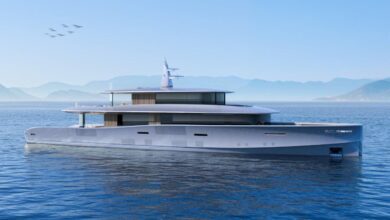2026 701-Horsepower Porsche 911 Turbo, First Look

📝 usncan Note: 2026 701-Horsepower Porsche 911 Turbo, First Look
Disclaimer: This content has been prepared based on currently trending topics to increase your awareness.
Porsche 911 Turbo S is available as both coupe and cabrio from launch. Cabrio S is without question the most indulgent bon vivant form of 911. Rear spoiler is an active aerodynamic element, but also hearkens to the famous “whaletail” of the original 930 Turbo of the 1970s. Note how clean the rear cowl and bodywork are.
STUDIO GOICO
Porsche Turbo’s legend has been writ with engine power, acceleration and top speed since the 930 Turbo of the 1970s, and for 2026 the new Turbo S does not disappoint, outperforming its immediate 2025 predecessor by considerable margins. How can it not deliver with 701 horsepower on tap?
Porsche 911 Turbo S for 2026 is now more powerful than ever, with no less than 701 horsepower and perhaps more importantly, 590 lb.-ft. of torque available from 2300 rpm up to 7000 rpm. Coupe pricing begins at $270,300, with Cabrio Turbo S starting at $284,300.
Porsche
In Launch Control the new Turbo S should hit 60 mph in 2.4 seconds, a time to rival pure electric hypercars. Porsche tells us that the Turbo S will reach 200 kph (124 mph) in 8.4 seconds, which indicates a quarter mile time in the 10-second range. Acceleration should prove relentless to 140 or 150 mph.
Turbo S is no flyweight, tipping the scales at 3829 lbs., fully 180 pounds heavier than its predecessor. But the benefits of electric twin turbos, massive gains in power and torque, and the 400 volt system that improves chassis dynamics more than make up for the added weight. In some ways, you can think of it as muscle added at the core, allowing the 911 Turbo S to punch a whole lot harder than its older brother.
Porsche
All this power is a gift of Porsche’s latest powertrain technology: electrically assisted turbochargers. Porsche calls their system T-Hybrid, as each turbocharger is a hybrid of sorts, combining in one component the instant-on boost at low revs of an electrically driven supercharger with the purity of a turbo fan powered by hot exhaust gases at higher revs. This technology is seen in Formula One.
2026 Turbo S is significantly more aero efficient than last year’s car. Active aero is obvious. Moveable vents on the left and right corners of the lower front fascia, and under the chin another active panel that adjusts airflow under the car. The rear wing will tilt to reduce or increase drag and downforce as the situation requires.
Porsche
At low revs, a compact 400-volt electric motor placed along the turbo’s central shaft instantly spins up the turbo and thus delivers loads of boost free of turbo lag. It’s due to this virtually instantaneous boost that maximum torque of 590 lb.-ft. is available from a very low 2300 rpm.
Inside, the dash may be 21st Century, but it reminds of the simple flat dash of the original 911 of the 1960s up to the 964 and 993 of the late 1980s and early 1990s. Flat screens for gauges, and for the central touchscreen. Note the center console sides incorporate padded sections for bracing knees during cornering.
Porsche
A half century ago, one put a boot into a 930 Turbo and counted till three to receive a wallop of power that only the most skilled drivers could manipulate and apply to good effect. In 2026, anyone with reasonable skills should be able to exploit this mountain of torque for impromptu street races.
2026 Porsche 911 Turbo S cabrio.
Porsche
Once engine exhaust flow is adequate, the twin turbos function in classic fashion, hot exhaust gases spinning the little windmills and delivering pressure to the combustion chambers. What we all call boost.
Active aero vents. Note how splitter wraps around, channeling air to the wheel arch.
Porsche
In its early releases, Porsche has not defined the point where the electric motors hand off to the flow of hot exhaust gases, but the results are maximum torque all the way to 6000 rpm. I had to double- and triple-check the spec sheet to ensure I got that right. Porsche calibration will no doubt ensure delivery that’s sweet and silky. Peak horsepower is available between 6500 and 7000 rpm.
Sport Chrono package includes active suspension management, and a full titanium exhaust that will ting-ting to your heart’s delight when cooling off after a fast drive. Note aero element at backside of rear wheel arch.
STUDIO GOICO
Electric turbos have only one downside, and Porsche has cleverly made the very most of the additional weight of a 400-volt battery and needed hefty cabling. Porsche uses the 400-volt system to power an electro-hydraulic chassis system. It’s not a full active suspension system like on Panamera Turbo S hybrid, but it helps the chassis maintain a flatter stance in cornering, and achieve a balanced posture when entering or exiting a corner.
Clean design of center console. Controls are a combination of touchscreen with redundant “analog” controls on dash, center console, and steering wheel.
STUDIO GOICO
In coupe form, the new 911 Turbo S lapped the nearly 13-mile Nürburgring Nordschleife a stunning 14 seconds quicker than its 2025 predecessor. Chalk that up to the electro-hydraulic chassis control and the instant-on torque delivered by electric turbos.
Rear tires now measure 325/30 ZR 21, making them 10 mm wider than those of the previous car. Dimensions for the front tires remain the same: 255/35 ZR 20. Porsche Ceramic Composite Brake (PCCB) system is standard.
Porsche
For perspective on all this power, torque, and hammering acceleration, one must only look at specs for the original, the 930 Turbo of the 1970s, the foundation of the legend. My mechanic in high school and college had a dark green 930 Turbo and I still recall the sensations of that car nearly a half-century later. My college sports cars were hard-pressed to generate 100 horsepower so by comparison the 930 was Thor’s Hammer.
Simpler times, the 1970s. A 1975 930 Turbo (L) and a 1974 2.7 Carrera (Photo by Daniel Pullen/Future Publishing via Getty Images)
Future Publishing via Getty Images
Curb weight of the 930 was about 2600 lbs., about 1200 lbs. lighter than today’s all-wheel drive car, but the engine only produced 245 in the U.S. market, and 260 in the rest of the world. Keep in mind that every carmaker in the Seventies struggled to adapt to emissions regulations and still produce engines with any amount of power. At the time, the 930 Turbo was a shock to the world, an instant legend.
A Porsche 911 Turbo S is entirely civilized for everyday driving, but has remarkable performance capability.
STUDIO GOICO
So, sure the 2026 911 Turbo S weighs more, but it has nearly three times the horsepower as the original, an all-wheel drive system that puts all that power down efficiently, a sophisticated suspension, active aero control elements, a gearbox that shifts in milliseconds, and, well, an air conditioning system that can cope with Palm Springs or Scottsdale in August. The new Turbo S should prove civilized and refined, perfect for a placid date night saunter to a steak house, top down.
And oh yeah, the original 930 required 20 seconds to reach 124 mph, and the new car does it in 8 seconds and change. Remember, we are living in a Golden Era and the new 701-horsepower 911 Turbo S is proof. Certainly Thor is looking down with approval.




